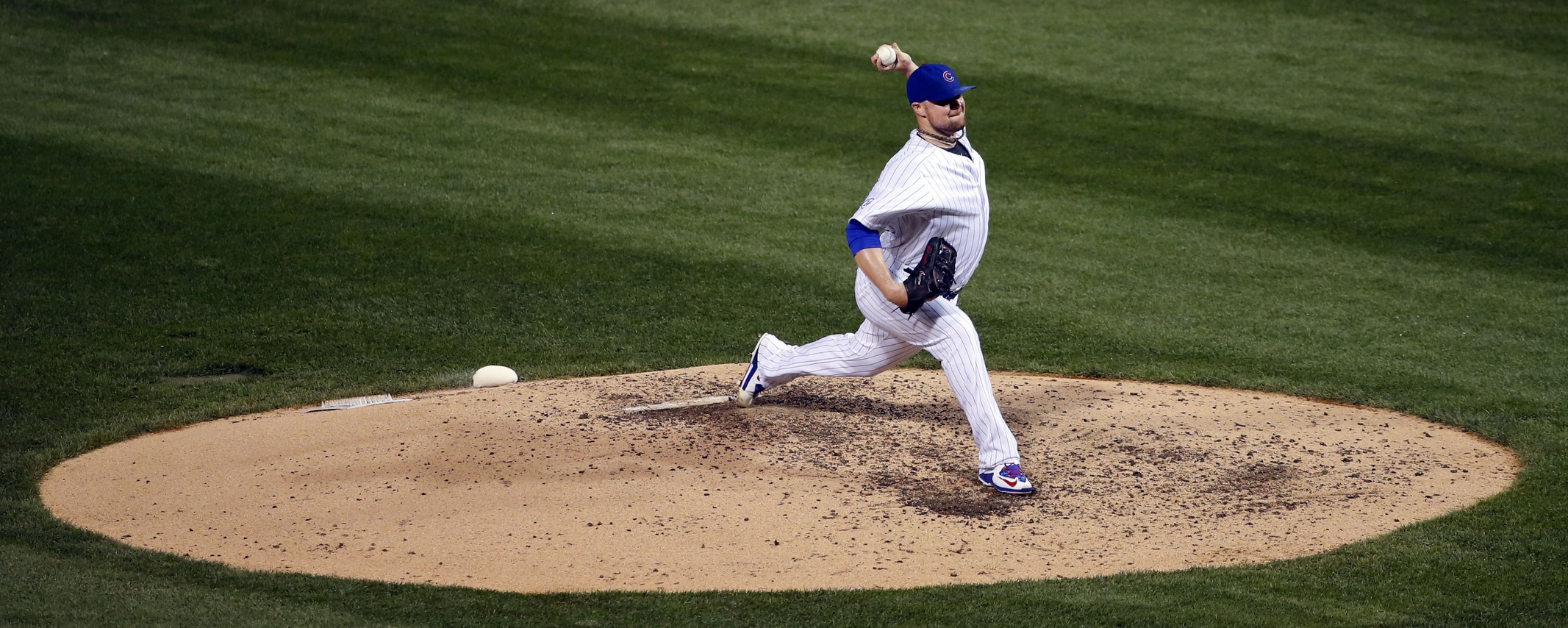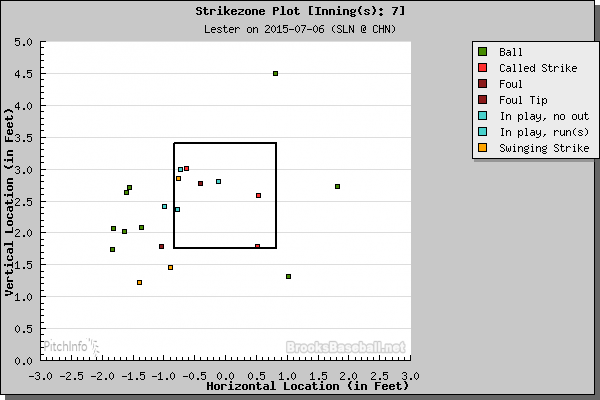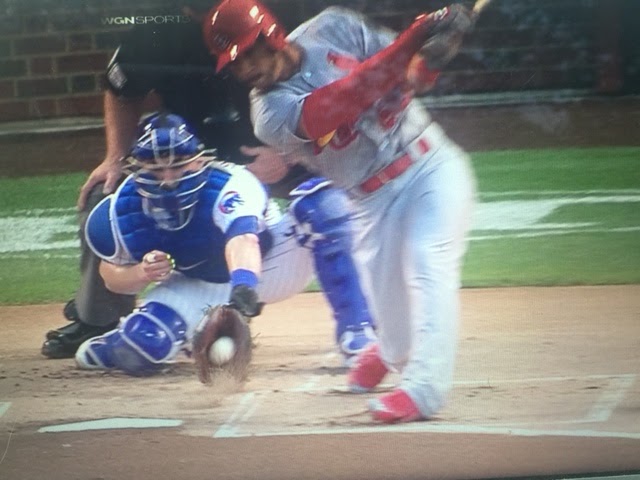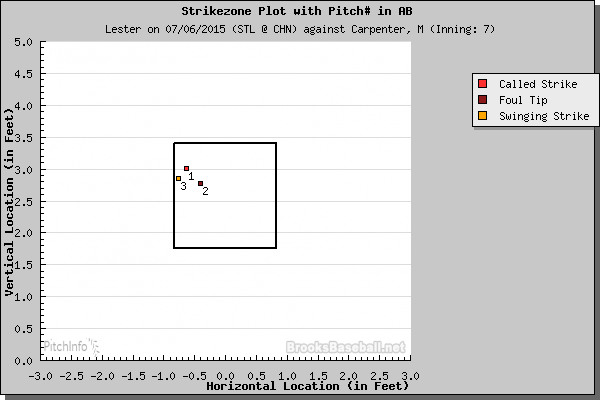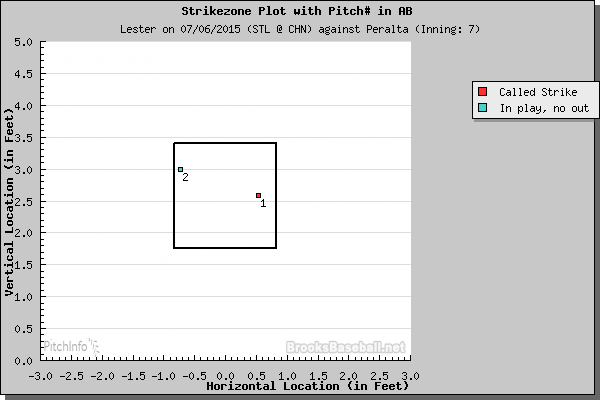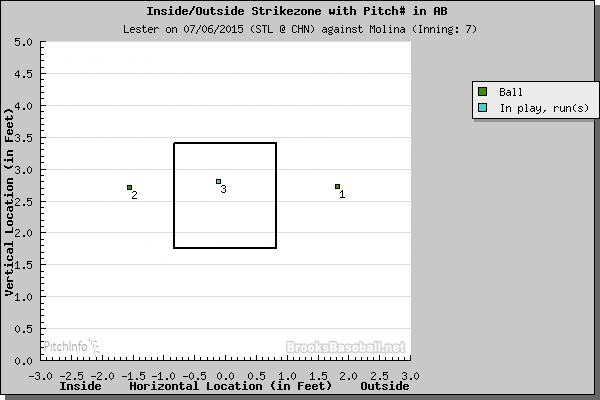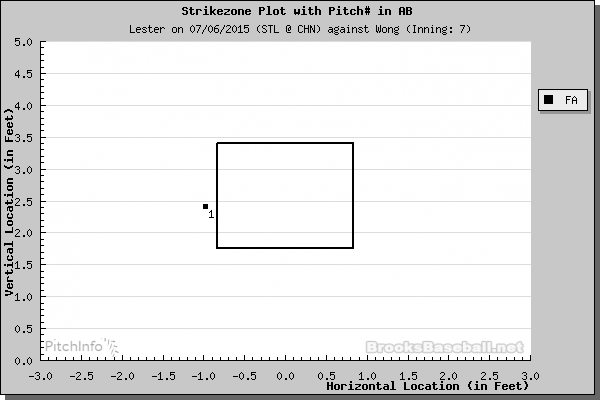Date: July 6
Opponent: St. Louis Cardinals
Location: Wrigley Field
Introduction
Damn you, baseball. It was amazing. Then it was stomach-churning. And finally, you wanted to punch the nearest wall, table, or inanimate red object. Damn. You. Baseball.
First the positive, because despite the stupid outcome, it should be acknowledged that Jon Lester’s 17th start of 2015 was his best, which admittedly, only adds to the night’s frustration. At one point, he retired 17 straight Cardinals batters, and he needed just 50 pitches to get through innings two through six. He set a season high with 13 whiffs on pitches outside of the strike zone. The 14 whiffs overall matched his second-best total of 2015. Lester got ahead of 16 of 26 batters (61.5 percent), and through the first six innings, he had got ahead of nearly 70 percent of Cardinals hitters (13 of 19). Lester was locating his fastballs consistently
Even the RBI single to Kolten Wong, which came on a first-pitch four-seam fastball, was a good pitch, based on Wong’s 2015 track record and his first two at-bats of the night against Lester (see Key At-Bat/Sequence section).
The Cardinals entered the night in the middle of the National League pack in runs scored and most power categories (home runs, ISO, slugging percentage, and home run to fly ball ratio).
However, as a team, they lead the NL in doubles, rank third in on-base percentage, fourth in batting average, and fifth in walk rate. Also, of the seven players with at least 200 plate appearances, five have at least a .770 OPS and .260 TAv. The Cardinals do not hit for much power, but they get on-base and produce the singles and doubles needed to drive in runs.
As a team, they have struggled against left-handed pitcher, hitting just .233/.309/.360 with a 24.7 percent strikeout rate. That production is about nine percent below league average against left-handers, according to sOPS+. Entering Wednesday night’s game, several of their everyday players (including three All-Stars in 2015), are performing below their career numbers against left-handed pitchers:
| 2015 OPS vs. LHP | Career OPS vs. LHP | |
| Yadier Molina | .538 | .763 |
| Mark Reynolds | .725 | .805 |
| Matt Holliday | .827 | .907 |
| Matt Carpenter | .623 | .753 |
| Kolten Wong | .689 | .700 |
As has so often been the damn case, though, the Cardinals offense survives under performances from key contributors, with the sum total turning out greater than its parts.
A different bounce to and decision by Bryant in the span of four pitches, and we might be talking a Lester no-hitter, or a shutout, or at least a complete game. Amazingly, he has not pitched into the eighth inning of a game in 20 consecutive starts going back to September 2014, his longest stretch since 2006-2007. While Wednesday’s outcome was disheartening, disappointing, and dis-not cool, it was Lester’s best start as a Chicago Cub. Continue reading below for equal parts dominance and heartbreak.
Traditional Line
7.0 IP, 2 H, 8 K, 2 BB, 2 R (0 ER)
Pitch Breakdown
95 pitches (62 strikes)
| Total | Velocity (Max) | AVG | SLG | BABIP | |
| Four-Seam | 37 | 92.3 (94.9) | .111 | .111 | .167 |
| Cutter | 32 | 88.3 (89.9) | .111 | .111 | .200 |
| Sinker | 6 | 90.0 (91.3) | .000 | .000 | .000 |
| Changeup | 7 | 84.1 (85.0) | .000 | .000 | .000 |
| Curveball | 13 | 74.3 (76.7) | .000 | .000 | .000 |
This was a noticeably different approach than Lester’s first two starts against the Cardinals, when he went to his four-seamer 50.8 percent of pitches, about 12 percent below his season average:
| Frequency | Strikeouts | AVG | OBP | SLP | |
| Four-Seam | 50.8% | 7 | .313 | .350 | .333 |
| Cutter | 23.6% | 4 | .368 | .619 | .579 |
| Sinker | 7.2% | 0 | .000 | .000 | .000 |
| Changeup | 4.6% | 0 | .333 | .333 | .667 |
| Curveball | 13.9% | 1 | .333 | .333 | .500 |
Interestingly, Lester still went to the cutter and four-seamer a combined 73 percent against the Cardinals, just with the cutter appearing with increased frequency. In fact, for the second consecutive start, Lester featured the cutter prominently. Against the Cardinals, he used the pitch to record four of his eight strikeouts, and surrendered just the one infield single. Perhaps this was a development. Perhaps the Cardinals should have seen this coming, as on May 6 they went just 3-for-18 with six strikeouts against Lester’s cut-fastball.
Lester threw first-pitch four-seam and cut fastballs to 20 of 26 batters, with 12 first-pitch strikes. Of the 12, Cardinals swung at only four, allowing Lester to get ahead in the count. On the night, Cardinals batters were just 2-for-18 with seven strikeouts. This was a far cry from Opening Night, when just against left-handed batters, Lester went to his four-seamer and cutter a combined 84.6 percent of pitches. The Cardinals left-handers responded by going 6-for-11 with a walk and two doubles.
All was not perfect with the fastball, though. Of the four seventh-inning batted balls put in play that led to a run or batter reaching base, all were on four-seamers and cutters left up in the zone:
Lester threw just 13.7 percent curveballs (13 of 95), his lowest total since June 9 at Detroit. As usual, though, the pitch was working for Lester. The Cardinals batters were again hitless against the curve, including Tommy Pham’s strikeout to lead-off the game (see Trends section).
Trends
In the past two starts, Lester’s cutter usage has been nearly 10 percent above his season average, as you can see below:
| Frequency | K% | BB% | AVG | SLP | BABIP | |
| Starts 1-15 | 26.8% | 22.9% | 7.6% | .313 | .500 | .391 |
| Starts 16-17 | 36.1% | 28.0% | 8.0% | .182 | .273 | .267 |
While Lester did use the cutter to put away Cardinals batters (four strikeouts), he was able to use it to set-up his curveball, which is always the sign of an effective Lester. After he came inside with an 89 mph cutter to even the count at 2-and-2 to Tommy Pham leading off the game, Lester unleashed this 75 mph curveball in the dirt:
Lester and Miguel Montero had Pham thinking up and in, and got him to whiff on the curve for strike three. As we have beat into the ground covered extensively, Lester is at his best when he is able to use his fastballs to set-up his curveball.
Unfortunately, a badly missed spot with a cutter to Molina would lead directly to the Cardinals first run (see Key At-Bat/Sequence section). He did not miss often with fastballs, but when he did, the Cardinals batters made him pay the price. However, if Lester continues to locate and dominate with his cutter the way he has through early July, his 2015 will take further strides in the right direction.
Key At-Bat/Sequence
Inning: Seventh Inning
Score: 0-0
Situation: One out, Jason Heyward on second base, Jhonny Peralta on third base
Batter(s): Yadier Molina and Kolten Wong
Entering Wednesday, Lester had pitched a great game in the seventh inning this season:
7.1 IP, 0.00 ERA, 1.048 WHIP, .160/.250/.200
Opening the seventh inning, Lester continued to dominate both the game and the inning, striking out Matt Carpenter on three well-placed four-seamers on the outside corner of the plate:
With one out, Peralta singled off of Bryant’s glove, the Cardinals first hit, on a 89 mph cutter that stayed way up in the zone:
On May 6, Peralta homered off another Lester 89 mph cutter that missed its spot, this time right out over the plate:
It was a curious pitch selection, as not only had Peralta homered off the pitch previously this season, but he entered the game batting .350/.409/.700 against cutters in 2015. In any case, the Cardinals had their first hit and the start of a rally.
Now it is time we play the “What If?” game. What if Bryant had gone to first on Heyward’s ground ball? That would leave Peralta standing on second base with two outs for Yadier Molina. Entering the game, Molina had a .538 OPS against left-handed pitchers this season and a career .502 OPS against Lester. Instead, Heyward’s chopper on a 2-1 pitch put runners on first and third with one out.
Molina came into the game without having recorded a hit, or even reached base, against cutters from left-handed pitchers in 2015. On 2-0, Lester missed badly with an 88 mph cut-fastball, as mentioned above in the Trends section:
Few major-league hitters will miss that pitch, and Molina lined the flat cutter into right field for a sacrifice fly and the game-winning run.
Now with two outs, and Jason Heyward on second base, Kolten Wong stepped to the plate.
Entering the game, Wong was hitting .235/.381/.294 against four-seam fastballs from left-handed pitchers this season. Additionally, in each of his first two at-bats against Lester, Wong had taken a four-seam fastball in the exact same location for a called strike one. With Lester laboring slightly, he and Montero were likely hoping Wong would be taking again on the 92.6 mph fastball for a quick and easy first pitch strike:
This time, Wong was ready for the four-seamer off the plate, and he lined it into left field for a RBI single. In my opinion, Wong hit a good pitch, both in terms of selection and execution. The four-seamer stayed off the plate, but Wong was still able to hit a line drive to the opposite field.
After a walk to Mark Reynolds, Lester struck out Randall Grichuk on 90 mph cutter to end the inning and strand two runners. Lester had escaped further damage, but his night was over.
Keep-In-Mind
In the Twitter-verse and mainstream media there remains considerable consternation with Lester’s first-half, even after his brilliance against the Cardinals. However, after Lester’s two poor starts at Miami and Detroit to open June, he has quietly put together a solid five game stretch:
| IP | ERA | WHIP | K% | BB% | AVG | OBP | SLG | HR | |
| Starts 13-17 | 31.1 | 1.72 | 0.958 | 25.6% | 9.1% | .174 | .248 | .275 | 1 |
Wednesday night’s game was his best start of 2015 by Game Score (75), and four of his five best scores have come during this five start stretch. Yes, his .231 BABIP during this brief stretch is unsustainable, but it comes on the heels of the .485 BABIP at Miami and Detroit. Five starts do not a season make, but he has looked very similar to vintage Lester for the past month.
Conclusion
Lester did not complete the no-hitter, the shutout, or the game. He did not even pick up the victory, and his career-long winless streak stretched to nine starts. After attacking the Cardinals with four-seam fastballs in April and May, Lester found success with his cutter, which has been excellent for two consecutive starts. His curveball usage was sparse, but effective. It is frustrating, to be sure, but as I wrote after his May 1 win against the Milwaukee Brewers:
“The four-seam and cut fastballs were located consistently, not catching too much of the plate like in the preceding starts…The weather is warming up and Lester is looking more and more like the staff ace the Cubs were expecting. It’s starting to come together.”
Replace Ross with Montero, and the same holds true for Lester since early June (minus the start against the Dodgers). I practically wrote Lester’s season’s obituary after his season-worst start against the Dodgers, but he has looked significantly better in July, albeit against two teams in the bottom half on the NL in runs scored. It is coming together, again, but he just could not catch the necessary breaks on Wednesday night. It is remarkable (or depressing) how baseball can go from the best to the worst in a handful of pitches.
Season to Date
4-7, 3.48 ERA (5.21 DRA), 1.277 WHIP, 23.2 K% , 6.9 BB%
Next Start
Saturday, July 11 vs Chicago White Sox (Chris Sale)
Lead photo courtesy of Kamil Krzaczynski-USA TODAY Sports
